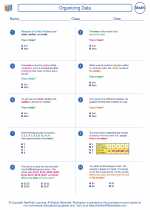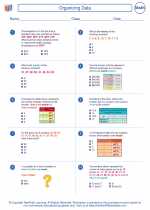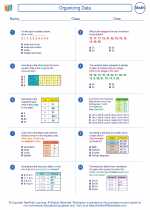Organizing Data -> frequency table
Frequency Table
A frequency table is a way to organize data in a tabular format, showing the number of times each value occurs within a dataset. It is a useful tool for analyzing and interpreting the distribution of data.Steps to Create a Frequency Table
- Collect Data: Gather the dataset for which you want to create a frequency table.
- List the Values: List all the distinct values present in the dataset.
- Tally the Frequencies: Count the number of times each value appears in the dataset and record the frequency for each value.
- Organize the Data: Arrange the values and their frequencies in a table format, with the values in one column and their corresponding frequencies in another column.
Example
Suppose we have the following dataset representing the number of pets owned by students in a class:- 2, 1, 3, 2, 4, 3, 2, 2, 1, 3, 2, 4, 3, 2, 1
- Collect Data: We have the dataset mentioned above.
- List the Values: The distinct values in the dataset are 1, 2, 3, and 4.
- Tally the Frequencies: Counting the occurrences, we find that 1 occurs 3 times, 2 occurs 6 times, 3 occurs 4 times, and 4 occurs 2 times.
- Organize the Data: We can organize the data into a table as follows:
Number of Pets Frequency 1 3 2 6 3 4 4 2
Study Guide
To effectively understand and work with frequency tables, consider the following key points:- Understand the concept of frequency and how it relates to the dataset.
- Practice creating frequency tables for different datasets.
- Learn to interpret the distribution of data using frequency tables, including identifying the most common and least common values.
- Explore the use of frequency tables in various real-life scenarios, such as survey data, test scores, or demographic information.
[Frequency Table] Related Worksheets and Study Guides:
.◂Math Worksheets and Study Guides Seventh Grade. Organizing Data
Study Guide Organizing Data
Organizing Data  Worksheet/Answer key
Worksheet/Answer key Organizing Data
Organizing Data  Worksheet/Answer key
Worksheet/Answer key Organizing Data
Organizing Data  Worksheet/Answer key
Worksheet/Answer key Organizing Data
Organizing Data 

 Worksheet/Answer key
Worksheet/Answer key
 Worksheet/Answer key
Worksheet/Answer key
 Worksheet/Answer key
Worksheet/Answer key

The resources above cover the following skills:
Data Analysis and Probability (NCTM)
Select and use appropriate statistical methods to analyze data.
Find, use, and interpret measures of center and spread, including mean and interquartile range.